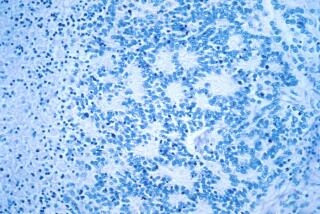New Way to Find Leukemia Cells May Spot Relapses
- Share via
TORONTO — Researchers reported Wednesday the discovery of a method of spotting leukemia cells that could help detect relapses earlier in children who suffer from one of the most common forms of childhood cancer.
The researchers, who reported their findings in the New England Journal of Medicine, said the new test also showed that some children believed to be successfully treated for acute lymphoblastic leukemia still retained some leukemia cells in their bone marrow.
“We’re thrilled because it really is brand new and there are all kinds of ramifications,” Dr. Melvin Freedman, who led the five-member research team at Toronto’s Hospital for Sick Children, said in an interview. “It’s really quite a discovery.”
Leukemia is a disease of bone marrow and blood-forming organs that sparks increased numbers of leukocytes, abnormal white blood cells that suppress production of normal white cells, red cells and platelets. Acute lymphoblastic leukemia affects one in every 2,500 children less than 15 years old and is one of the most common forms of childhood cancer.
Half Apparently Cured
The disease is usually treated by chemotherapy. If successful, symptoms disappear and it is said to be in remission. About half the children are alive and apparently cancer-free after five years.
It is difficult to detect one leukemia cell in 100 normal cells under conventional examination by microscope. The new test developed by Freedman and Dr. Zeev Estrov can detect one leukemia cell in 3,000, Freedman said.
Researchers used the new method to study bone marrow samples of 13 children in remission and found six still had leukemia cells. All samples appeared normal under conventional microscope examination.
Four Relapse
Four of the six children found to have leukemia cells under the new test, including one who had received a successful bone marrow transplant, relapsed within two to 30 months after testing positive, Freedman said.
The other two remained in remission, as did the seven whose bone marrow showed no leukemia cells.
Freedman said the test could one day be used in early detection of relapses in acute lymphoblastic leukemia and other types of the disease, although it is too early to tell where the research is headed.
“We are not yet in a position to suggest changes in chemotherapy or in management,” he said. “We are telling parents that just because we detect cells, that doesn’t mean the child will relapse.”






